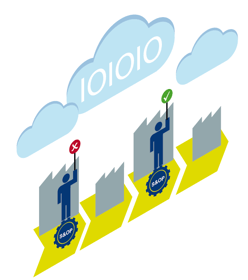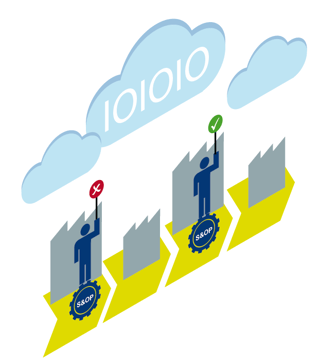Can S&OE Create A More Responsive Supply Chain?
Nick Ostdick - September 12, 2017

 Administering an integrated supply chain in today’s manufacturing industry is a tricky proposition. No matter how carefully and thoroughly planners and managers work to reduce volatility and uncertainty in any number of variant-rich industries, the complexity of a global manufacturing and supply stream means companies must work harder than ever to ensure their value streams are responsive enough to weather potential breakdowns, disruptions, shortages, and other obstacles in facilitating effective supply chain management.
Administering an integrated supply chain in today’s manufacturing industry is a tricky proposition. No matter how carefully and thoroughly planners and managers work to reduce volatility and uncertainty in any number of variant-rich industries, the complexity of a global manufacturing and supply stream means companies must work harder than ever to ensure their value streams are responsive enough to weather potential breakdowns, disruptions, shortages, and other obstacles in facilitating effective supply chain management.
To help cut through this complexity and increase how efficiently manufacturing companies can respond to changing variables or constraints in planning and production programs, planners and managers have something of a new tool at their disposal: sales and operations execution (S&OE). Coined in the last few years by supply chain industry publication Gartner, S&OE acts as a demand planning supplement or safety net to detect the possibility of bottlenecks or breakdowns in larger-scale planning platforms. This in turn allows planners and managers to create and deploy solutions to these disruptions to enhance each touchpoint of a company’s overall value chain.
While S&OE may be a relatively new concept in global supply chain management, its value has already been realized across nearly every aspect of the automotive production landscape. But even so, much is still misunderstood or unrealized about the value of S&OE in executing short-term planning and production decisions and as a crucial check on long-term planning by allowing for real-time modifications in the short and even mid-term. In order to fully understand how S&OE enhances supply chain management, we’ll examine what exactly S&OE can offer in helping creating a more responsive supply chain.
What S&OE really means
S&OP in the automotive supply chain is well-understood and realized concept for planners and managers in terms of monthly or bi-monthly production planning based primarily on part families. If you think about supply chain planning as a camera, S&OP is the mid-range zoom feature where planners and managers are able to glimpse into the mid-term future to assess production capabilities, demand for products, inventory levels, and facility allocation capacity. On the other hand, annual planning operates on a yearly basis and acts more like a long-range zoom on the camera for planners and managers to execute long-term planning actions on a macro-scale.
Where S&OE comes in is something of a ultra-zoom feature on the camera for close inspection of weekly supply chain planning practices which can also be a key indicator as to the viability of S&OP or annual planning. Essentially, S&OE functions as a quick, short-term snapshot of the overall supply chain situation for planners and managers to make vital course corrections on a weekly basis to better create long-term strategies. In addition, whereas S&OP and annual planning often deal in forecasting, simulations, and other hypothetical supply and production scenarios, S&OE tracks actual demand and production metrics in real-time for a more accurate picture of the demand and production stages.
S&OE in creating a responsive supply stream
Now that we understand a bit more about what S&OE really means, we can examine just how S&OE principles and concepts can help planners and managers create a more agile supply stream. Because of the complex nature of partner networks, disparate production sites and facilities, and the complicated processes involved with transport logistics, S&OE is a critical value proposition in creating and promoting greater supply chain flexibility via:
Optimizing reactions to SCM fluctuations: For planners and managers, supply chain agility is a top concern when evaluating overall supply chain management. However, in today’s fast-paced production landscape, micro-agility, or the ability to respond to sudden disruptions on a daily basis, has emerged a pressing issue in leveraging effective, lean supply chain principles. Late shipments, forecast errors, and other small-scale disruptions can be mitigated via S&OE through improved scheduling and delivery reliability, reduction in raw materials overages or shortages, or fewer instances of rescheduled or reallocated production programs to meet customer demands. In addition, this optimization allows for greater integration with Industry 4.0 philosophy and theory.
Creating a space for end-to-end (E2E) visibility: Because S&OE provides a window into the weekly supply chain situation, planners and managers can essentially work backwards or forwards in the demand planning process to increase visibility across the supply stream on a number of levels, be it daily, weekly, monthly, or even yearly. This structure elevates the supply chain and makes it easy for individuals across the value chain to expose weaknesses or inefficiencies at any stage of the process, which in turn makes supply chain streamlining and optimization a much easier and effective end result to achieve.
An integration of advanced analytics: We discussed before on this blog about the value of advanced analytics in fostering lean supply chain management strategies and putting mountains of data and reporting to good use for more effective, accurate planning. Because advanced analytics operate primarily in real-time and provide planners and managers with an immediate window into supply and production cycles, S&OE functions in perfect harmony with advanced analytics in giving planners and managers an outlet for massive amounts of real-time data and metrics. Essentially, advanced analytics is the gasoline for short-term planning and modifications to production programs while S&OE is the car that requires the fuel.
LATEST POSTS
- Understand Why Production Planning Needs Specialized Solutions
- Understand Circular Economy in The Manufacturing Industry
- How Can Industry 4.0 IT Integration Be Achieved Smoothly?
- The Significance of Order Sequencing in Discrete Manufacturing
- How to improve your Supply Chain Management: The Power of Control Towers



